#pacu
Explore tagged Tumblr posts
Text

WE ARE NO LONGER COELACANTHS
TODAY WE ARE

PACU

!!Pacu Supremacy Forever!!
978 notes
·
View notes
Text

i love this website
1K notes
·
View notes
Text
Daily fish fact #720
Cachama!

Also known as a black pacu, black-finned pacu, giant pacu, tambaqui, just pacu... a beloved child has many names. This fish tends to shock folks due to its very human-like dentition, sporting flat, square-shaped teeth! The shape of the teeth can be explained by the diet of the cachama, as it mostly eats fruits, seeds and nuts, and needs ample biting surface to crack and crush them!
Below is an unidentified species of pacu.

#fish#fish facts#fishfact#biology#zoology#fishblr#pacu#cachama#tambaqui#black pacu#black-finned pacu#giant pacu#teeth
233 notes
·
View notes
Note
what is my government assigned fish?

You get a Red-Bellies Pacu
Piaractus brachypomus
126 notes
·
View notes
Text

feesh
#art#digital art#silhouette#pacu#Piaractus Brachypomus#fish#marine biology#i dunno what to tag this lmao#it's not paleoart or fanart#just a little guy#someone told me it looks like greek poetry art#made me so happy
128 notes
·
View notes
Text
[source]
#I don’t know anything about the dietary restrictions of a fish like this but I can’t stop watching him gulp down those sausages#Pacu#fish
480 notes
·
View notes
Text







(tropical) fish presentation system ^u^
perch - any queer who is agender/genderless presenting.
krib - any queer who is androgynous presenting.
tetra - any queer who is feminine presenting.
pacu - any queer who is masculine presenting.
puffer/pufferfish - any queer who is neutral presenting.
chalceus - any queer who is outherine presenting.
gourami - any queer who is xenine presenting.
view this doc for combination terms!
tagging @radiomogai!
19 notes
·
View notes
Text

246 notes
·
View notes
Text
58 notes
·
View notes
Text
APRIL FOOLS!

Hope you enjoyed this day of pacu!
(I love these dudes. Look at this goofy face)

❤️❤️❤️❤️❤️❤️❤️❤️❤️❤️❤️❤️❤️❤️❤️❤️❤️❤️❤️❤️❤️❤️❤️❤️❤️❤️❤️❤️❤️❤️❤️❤️❤️❤️❤️❤️❤️❤️❤️❤️❤️❤️❤️❤️
#pacu#april fools#i do love pacu#I also love how many people responded with “when did I start following a pacu blog?” and just shrug it off
292 notes
·
View notes
Text
my them (˶ᵔ ᵕ ᵔ˶)
their name is Pacu ฅᨐฅ (dnd character btw)




#traditional art#oc#small artist#traditional#dnd#dnd character#dnd oc#slime#pacu#my art#my oc#original character#they/them
8 notes
·
View notes
Text
Do you ever just want your co-worker to just eat their words so bad they apologize. Jesus, my co-worker, acts like she is so high and mighty. She acts like she is better than everyone cause she clocks in early. FUCKEN, pisses me off. Like bitch you are just a number to the company. Cool your shit. No one likes you here. You being here early does not change the fact that everyone hates you.

2 notes
·
View notes
Text
So this one was an absolute blast (and sometimes pain) to research in preparation for the stream and I love how Josch's piece came out.
And so that all that info isn't just hidden away I'll break this one down beyond the croc stuff. Big part of this was defining what would be used, which brings the often overlooked but important distinction between the Pebas Megawetlands as a whole and the Pebas Formation in particular. Obviously the latter was used for this piece, which largely removed other fossil localities like Fitzcarrald and most importantly La Venta of the Honda Group from the resource pool (La Venta being well known for its mammal fossils), but despite this there was still a lot of ground to cover.
Starting with the crocs, the Pebas Formation might just be the formation with the single highest Cenozoic croc diversity. Sure in total theres more taxa in places like Urumaco, but in that case they are spread out across very different biomes. Meanwhile, all 7 Pebas crocodilians are known from the same localities. Of those 7, 4 are featured in the piece, covering most of the different morphotypes. The ones left out were Paleosuchus sp. (an extinct species of dwarf caiman), Kuttanacaiman and Caiman wannlangstoni (the latter two being ecologically too similar to one that is featured).
Images by Joschua Knüppe, Wann Langston, Andrzej Wolniewicz and yours truly.
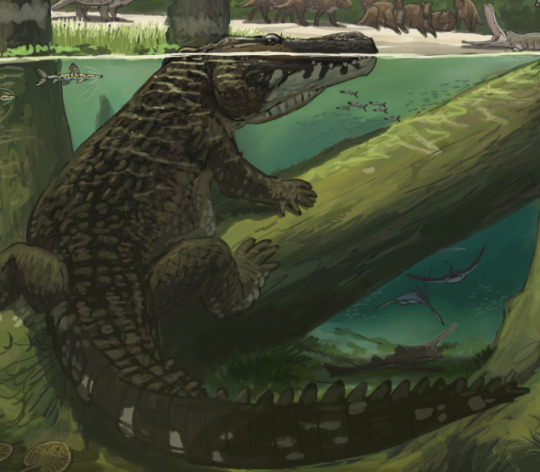
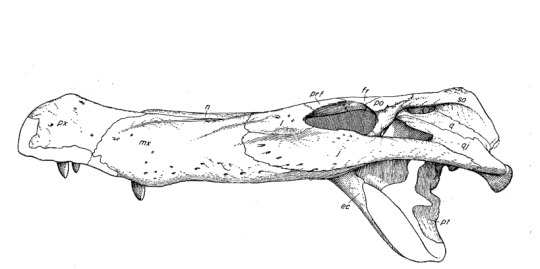
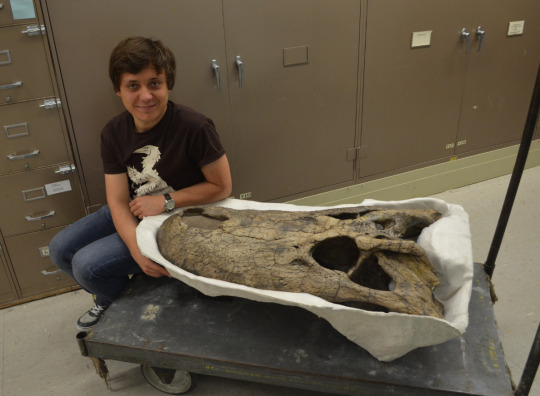


The first one that obviously had to be included was Purussaurus neivensis. I wager most are familiar with Purussaurus at least by hearsay, generally as "one of the biggest crocodilians" and all those estimates upwards of 10 meter in length. Purussaurus neivensis however is the oldest species in this genus and as such as nowhere near as big and has a notably less boxy head. It was still big mind you, when I scaled it some years ago I still got a size of 6 to 7 meters, though a paper published after that proposed a more modest 5 to 4 meters. Multiple localities have yielded bones of this thing and the locality of Na 069 has sloth fossils that bear bitemarks likely attributed to P. neivensis.
Images by Josch, yours truly and Salas-Gismondi R. et al.
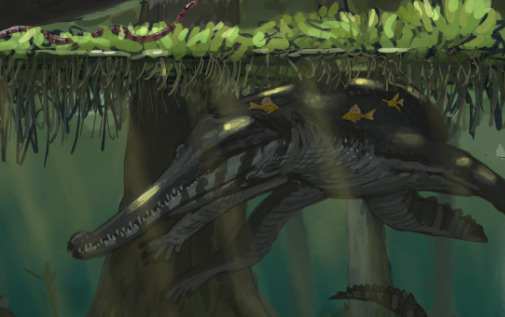
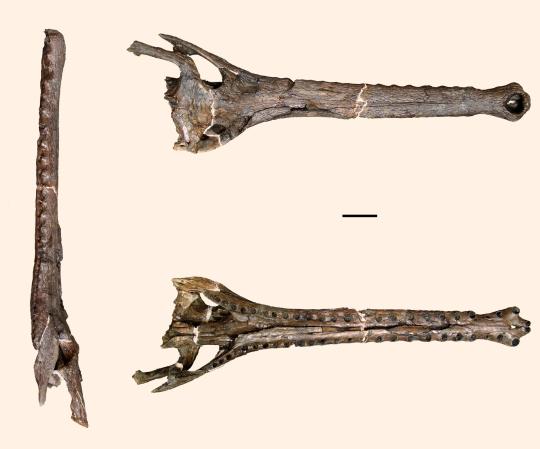
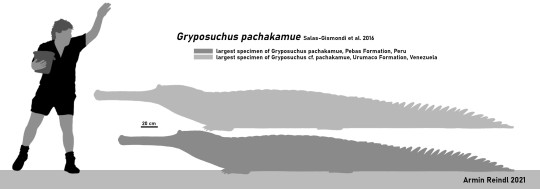
The second largest animal featured here is Gryposuchus pachakamue. Now as with Purussaurus, Gryposuchus is probably best known from its giant relatives like G. croizeti. Again the species encounted within the Pebas Formation is smaller and has some major anatomical differences, namely the fact that the eyes aren't telescoped. Quick context, if you look up the skull of modern gharials and derived Gryposuchus, you'll find that the rims of their eyes are raised, which elevetes the eyes. That's telescoping and not present in G. pachakamue. This might factor into habitat preferences and ecology. Telescope-eyed Gryposuchus are present in the Pebas Megawetlands, but do appear to stick to the edges and areas with flowing waters, like rivers, whereas G. pachakamue was found deeper in the oxygen-poor swamps. Another cool thing about this guy is that its the only crocodilian from the formation thats not a caiman, but a gharial. Long story short, gharials briefly colonized South America, thrived but sadly went extinct. Tho its possible that todays Indian Gharials are descendents of this South American radiation.
Artwork by Josch, skull reconstructions by Wann Langston, size comparisson by me
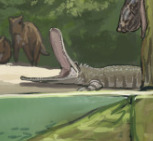
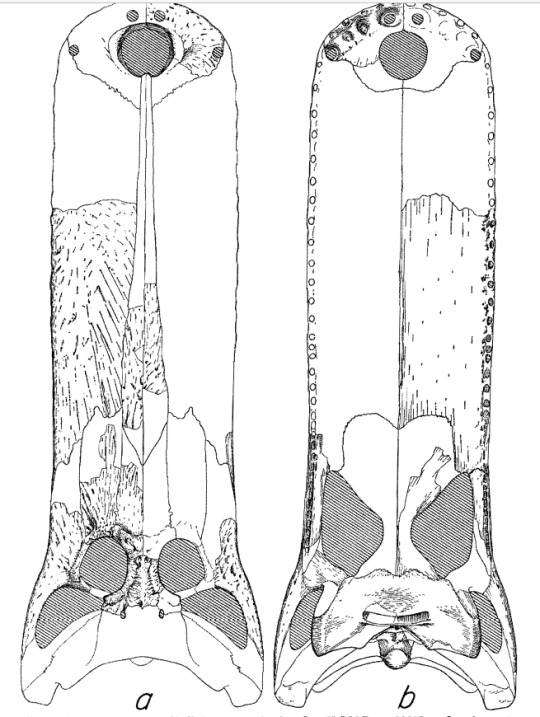
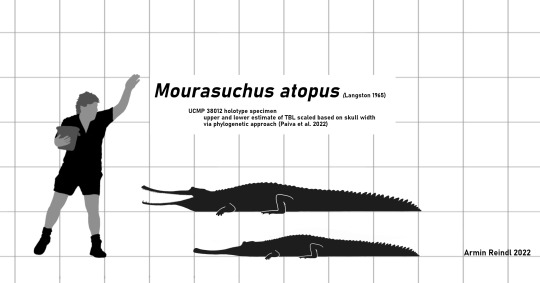

Third on our list is Mourasuchus atopus, which, I mean look at it. Mourasuchus takes us back to the caiman subfamily and it might just be the weirdest of the bunch. A flattened surfboard like head, highly telescoped eyes, lots of small teeth. These things are an enigma. Again the species present in this piece is on the smaller end of the spectrum and in general these animals are often way oversized in artwork and popular literature. The more interesting thing tho is their diet, which we still don't quite get. Theres been multiple hypothesis, including that it was a herbivore or that it waited with open jaws for fish to pass by. The hypothesis that has recieved the most attention is "filter feeding", tho the term is probably missleading as I'll explain. The idea is that Mourasuchus may have fed on small prey that could have hid in substrate or appeared in large numbers. Accordingly, it has often been depicted with a gullar pouch or similar to whales, largely based on a hypothesis erected for the unrelated Stomatosuchus, tho said hypothesis is not well supported either. Given that it lacks any obvious filter apparatus and may not have actually filtered anything, its perhaps more apt to describe it as a gulp feeder as used by Cidade et al. in their study. Which nicely leads into the name gulper caiman thats occasionally floated around.
Images by Joschua, Kevin Montalbán-Rivera and me
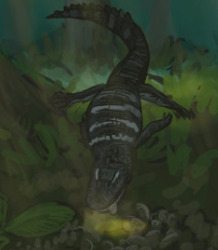

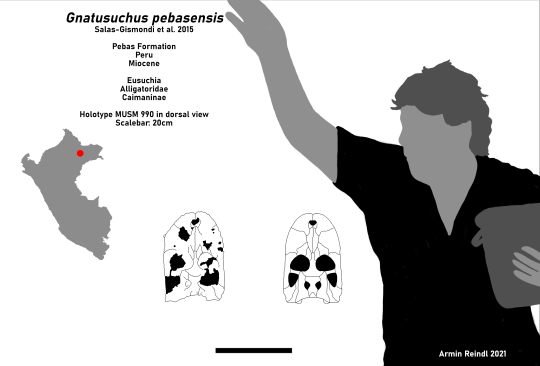
The final croc featured in this piece is Gnatusuchus (Nose Crocodile), the smallest of this selection at only around 1.5 meters long but not the smallest overall (that honour goes to the unnamed Paleosuchus species). Gnatusuchus represents the crusher morphotype. Basically, during this time period the wetlands had an incredibly diverse mollusc fauna with plenty of shellfish. These shellfish became prey to a variety of caimans that had blunt, globular teeth and generally shorter snouts. The afforementioned Kuttanacaiman and Caiman wannlangstoni both fall into this camp, but Gnatusuchus was probably the most extreme with its shovel-like skull and very round teeth. It is thought that they were the main predator of clams in the oxygen poor swamps, given that as air-breathers they didn't take issue to the water conditions in the same way that fish did.
Live reconstructions by Joschua, Paradracaena skull by Matt Borths, Pebasiconcha size by Ta-tea-two-te-to
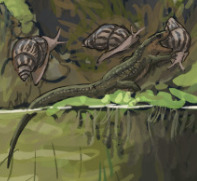
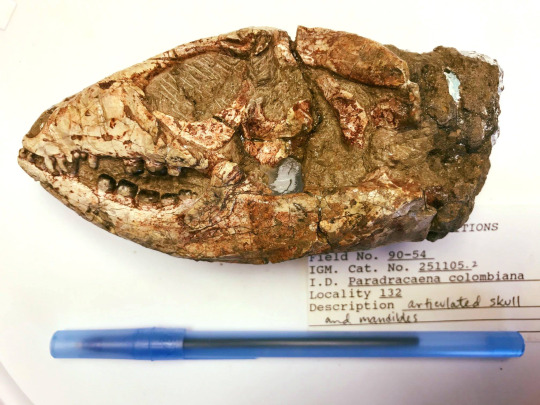

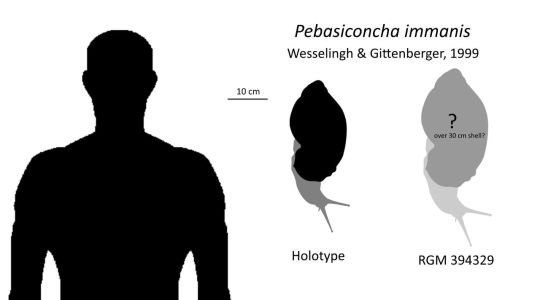
Crocs out of the way lets move on to other reptiles with Paradracaena and its would-be prey that I'll just cover here for simplicity. Now Paradracaena is an extinct relative of today's Caiman lizards and tegus and a good example of where La Venta really comes to help. The skull featured above is from La Venta for example, but we do have less complete fossils of this animal from the Pebas Formation, after all they are located within the same wetland system. Paradracaena was large, larger than modern caiman lizards and tegus, yet this one overestimates just how big its prey is. Pebasiconcha is among the largest known terrestrial snails with a size of possibly up to 30 cm (25 at the least of it), larger than even today's giant african land snails.
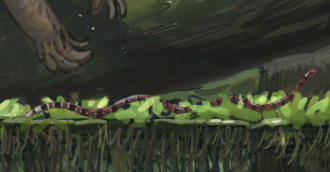
More hidden is this one, Colombophis, a relative of today's false coral snake. Now problem is, I know little to none about this animal so I'm afraid I cannot provide that much information on it other than that it was widespread across the megawetlands and its successor systems during the Miocene.
Joschua Knüppe and the University of California Museum of Paleontology
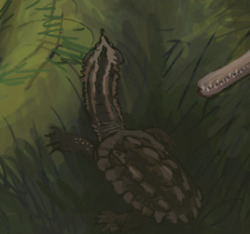
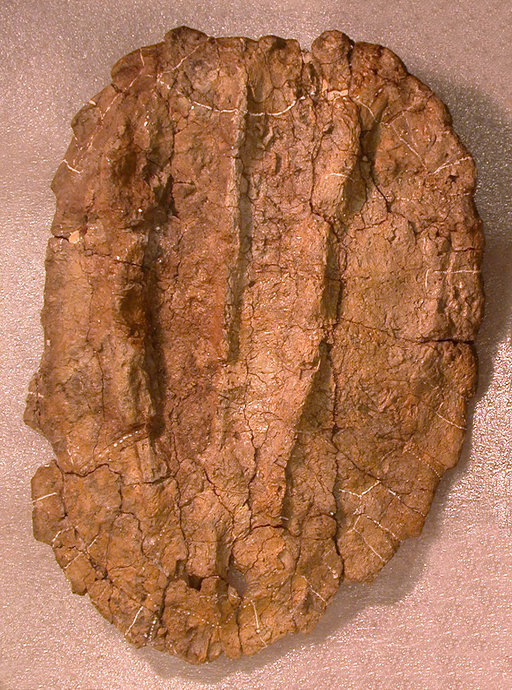
The final reptile to be covered is this guy, Chelus colombiana aka the Giant Mata Mata. This is another one that I know less about than I like and its been on my list to research and write about for a while, but to keep it brief Chelus colombiana is a relative of the modern mata mata turtle that reached a shell length of upwards of 70 centimeter. Given that Mata Matas have stupidly long necks, the full animal would probably exceed a meter in length. If I get around to it I'll go on a deep dive in the future, but I'll make no promises.
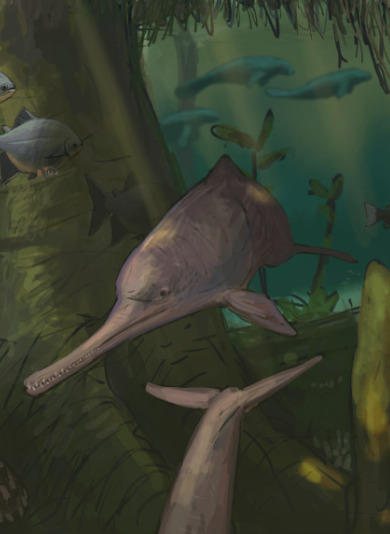
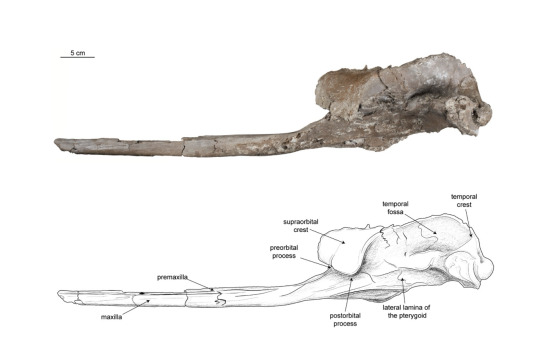
People who follow my blog should be familiar with this animal, given I've written a summary on it shortly after it was described (shameless plug here). Several cool things about this guy come to mind. Not only is Pebanista the largest river dolphin we know (at least of those that are described), measuring 3.5 meters in length, but its also entirely unrelated to the river dolphins that inhabit the Amazon today. Instead, as one might guess from the name, Pebanista is most closely related to the genus Platanista, which includes the Ganges and Indus river dolphins of South Asia. This family used to be a lot more common during the Oligocene prior to the rise of orcas, sperm whales and real dolphins, and both our modern ones and Pebanista seem to have fled competition into areas further inland. In the back you can also see manatees. Better known from other regions of the wetlands, manatees are known from the Pebas Formation itself through ribs and teeth.
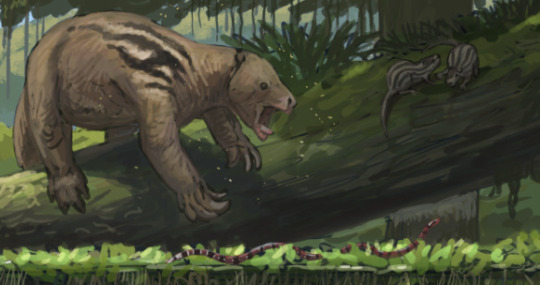

Moving on to the remaining mammal fauna. Again this is far from my expertise so I'll have to keep things relatively brief. First and most obvious we got the ground sloth, Magdalenabradys. Remember when I mentioned that we have caiman bite marks on some fossil remains, yeah its this guy. Which makes it all the better that in Josch's illustration the latter seems to sneak up on the former. Now when said bitemarks were described the sloth was identified as Pseudoprepotherium, but some digging by the other members of Paleostream has found that the Pebas specimens were later moved to the genus Magdalenabradys (hell the name of the type species even references how common this confusion is). Next to it you'll find Potamarchus, relatives of today's Pacarana and Josephoartigasia, the largest rodent ever. A more distant cousin to these guys is seen in the background next to Mourasuchus, Neoepiblema. THe morphology of the hindlimbs and pelvis suggest that they could have been digging or swimming animals, the latter seeming quite likely given the types of environments inhabited by them. And finally there's the glyptodont, specifically, bear with me, Parapropalaehoplophorus. Not making this up. Now a consistent theme with the Pebas Formation mammals is how little we know of them. Again, La Venta is easily the superior formation when it comes to mammal fossils, wheras the Pebas Formation proper mostly preserves fragments of taxa found in the former.
Fish I'll just keep to a quick footnote, having reached another area where I just know little about these animals to the point where I feel like without doing a proper deepdive I might just accidentally get something wrong. The most interesting might be the cow-nosed rays and the sawfish. Sawfish of course still inhabit the Amazon to this day, so perhaps this ones not so surprising. The cow-nosed ray stands out more, but several papers indicate the presence of either Myliobatis (the eagle ray) or Rhinoptera (the cownose ray). The latter ended up being chosen due to the work of Chabain et al., who also named three different species of Potamotrygon (bottom left next to Purussaurus), which are your typical South American river rays. The rest of the fish fauna here falls into your typical modern Amazonian fauna (Pacus, Plecos, Piranhas, Cichlids and various catfish) with Pogonias being the one outlier featured, as its closest kin are found in the Atlantic Ocean (tho they do occasionally venture into freshwater from what I could gather). In general there are some fossil fish from the formation that are either offshoots of lineages that are still marine to this day or early offshoots of groups that would eventually become fully freshwater, highlighting how these fish, much like the dolphins, took the opportunity presented by these enormous wetlands to expand into new habitats.
And thats all I have to say, thankfully I somehow managed to keep this under Tumblrs 30 picture limit.
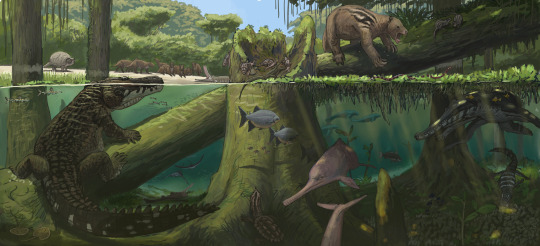
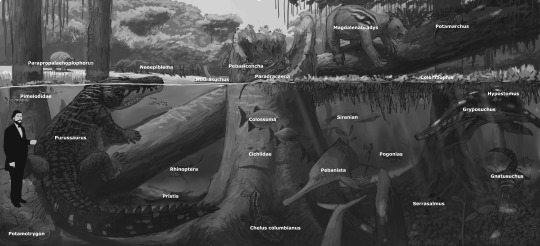
Result from the Pebas formation #paleostream!
Not as diverse as some other places he have hit and yet, we weren't even able to put in all the crocs.
#pebanista#gryposuchus#purussaurus#gnatusuchus#mourasuchus#chelus colombiana#paradracaena#pebasiconcha#sawfish#pacu#piranha#pebas#pebas formation#pebas megawetlands#peru#miocene#cenozoic#prehistory#paleontology#palaeoblr#paleostream#long post#fossils#magdalenabradys#neoepiblema#science#biology#swamp#Parapropalaehoplophorus#glyptodont
847 notes
·
View notes
Text
Pacu assado na brasa

0 notes

